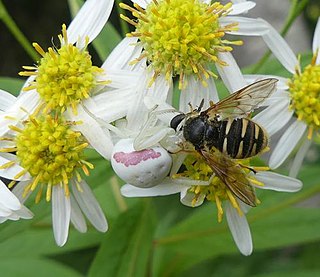
Syrphus ribesii is a very common Holarctic species of hoverfly. Its larvae feed on aphids. In common with many other species of hoverfly, males have the eyes meeting on the top of the head, whilst females have their eyes widely separated.

Syritta pipiens, sometimes called the thick-legged hoverfly, is one of the most common species in the insect family Syrphidae. This fly originates from Europe and is currently distributed across Eurasia and North America. They are fast and nimble fliers, and their larvae are found in wet, rotting organic matter such as garden compost, manure, and silage. The species is also commonly found in human-created environments such as most farmland, gardens, and urban parks, wherever there are flowers. This species is an important part of its native ecosystem as adult Syritta pipiens flies are critical pollinators for a variety of flowering plants and the species supports parasitism by various parasitic wasp species. Thus, they play an important role in environmental functionality, and can serve as bio-indicators, in which their abundance can reflect the health of the environment. Syritta pipiens looks like many predatory hoverfly species, yet is not predatory.

Meliscaeva cinctella is a Holarctic species of hoverfly.

Syrphus vitripennis is a very common European and North American species of hoverfly. Its larvae feed on aphids

Epistrophe grossulariae is a Holarctic species of hoverfly.

Melangyna umbellatarum is a Holarctic species of hoverfly.

Brachyopa flavescens, The Yellow Sapeater, is a fairly common species of syrphid fly. It has been observed in northeastern North America. Hoverflies get their names from the ability to remain nearly motionless while in flight. The adults are also known as flower flies for they are commonly found around and on flowers, from which they get both energy-giving nectar and protein-rich pollen. Larvae for this genus are of the rat-tailed type. B.flavescens larvae have not been described.

Blera badia, the Common Wood Fly, is a common species of syrphid fly first officially described by Walker in 1849. Hoverflies get their names from the ability to remain nearly motionless while in flight. The adults are also known as flower flies for they are commonly found around and on flowers, from which they get both energy-giving nectar and protein-rich pollen. The larvae are of the rat-tailed type, feeding on exuding sap or in the rot holes of trees.

Sericomyia bifasciata, the Long-nosed Pond Fly, is an uncommon species of syrphid fly. They have been observed from the northeastern part of North America. Hoverflies get their names from the ability to remain nearly motionless while in flight. The adults are also known as flower flies for they are commonly found around and on flowers, from which they get both energy-giving nectar and protein-rich pollen. The larvae in the genus Sericomyia are known as the rat-tailed with a long breathing tube taylored for aquatic environments. The larvae for this species are unknown.
Blera flukei, the Red-cheeked Wood Fly, is a rare species of syrphid fly first officially described by Curran, 1953 as Cynorhina flukei. Hoverflies get their names from the ability to remain nearly motionless while in flight. The adults are also known as flower flies for they are commonly found around and on flowers, from which they get both energy-giving nectar and protein-rich pollen. The larvae are of the rat-tailed type, feeding on exuding sap or in the rot holes of trees.
Sphegina (Asiosphegina) atrimanus is a species of hoverfly in the family Syrphidae found in Vietnam.
Sphegina crinita is a species of hoverfly in the family Syrphidae found in Malaysia and Indonesia. It's easily identified by its superior lobes, the left side one being pushed over the medial line of the hypandrium to the right side so that the right side one seems bilobed. Otherwise, the genitalia are nearly identical to those in S. fimbriata.
Sphegina (Asiosphegina) achaeta is a species of hoverfly in the family Syrphidae found in Myanmar. It's easily identified by the weak setae on abdominal tergite I. It's similar in appearance to S. adusta but easily differentiated upon closer examination. The male genitalia are similar to S. pollex and S. culex, though it can be distinguished by having an acute posterodorsal corner of the superior lobe and a broader surstylus; it differs further from S. pollex by lacking a sub-basal dorsal thumb-like lobe. The arrangement of bristles on tergite I is similar to S. japonica.
Sphegina (Asiosphegina) atricolor is a species of hoverfly in the family Syrphidae found in Myanmar.
Sphegina (Asiosphegina) bidens is a species of hoverfly in the family Syrphidae found in Myanmar.
Sphegina (Asiosphegina) bilobata is a species of hoverfly in the family Syrphidae found in Myanmar. It's set apart from other species by its general pale yellowish color with three black longitudinal stripes on the scutum combined with the infuscated pattern at cross veins on the wing. The male sternite IV with its symmetrical pair of short spinose lobes posteriorly is quite distinct.
Sphegina culex is a species of hoverfly in the family Syrphidae found in Kambaiti Pass, Myanmar, a montane forest with swampy areas and streams located 2000 meters above sea level.
Sphegina cultrigera is a species of hoverfly in the family Syrphidae found in Kambaiti Pass, Myanmar, a montane forest with swampy areas and streams located 2000 meters above sea level.

Brachyopa caesariata, the Plain-winged Sapeater, is an uncommon species of syrphid fly. It has been observed in Canada, Alaska and northern United States. Hoverflies get their names from the ability to remain nearly motionless while in flight. The adults are also known as flower flies for they are commonly found around and on flowers, from which they get both energy-giving nectar and protein-rich pollen. Larvae for this genus are of the rat-tailed type. B.caesariata larvae have not been described.

Eupeodes perplexus the Bare-winged Aphideater, is a common species of hoverfly. Adults feed on nectar; larvae feed on aphids and scale insects.











